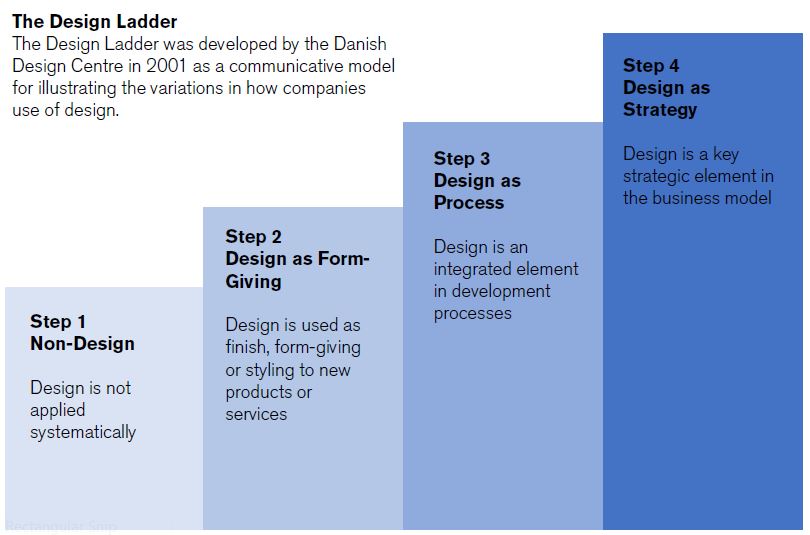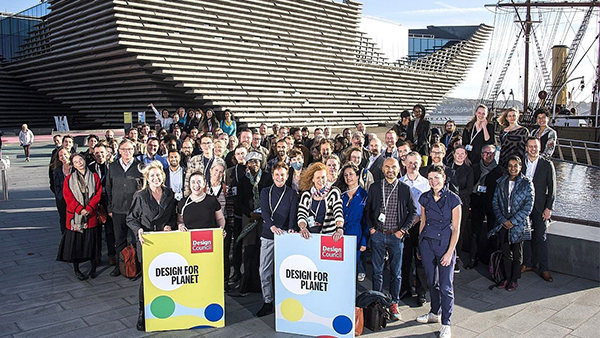Today the RSA publishes a new paper exploring the role of design in unlocking the creative potential 21st century industry. Supported by Innovate UK, the RSA seeks to better understand the challenges and opportunities presented by design, explore new design applications and stimulate a cross-sector dialogue about what a successful design-led future might look like.
UK industry is at a defining moment as it enters this age of automation; there is exponential opportunity for designers to create new technologies, new markets and new sectors. If there is widespread acknowledgement that design is a core tool in unlocking the potential of industry and contributing to national growth and innovation, we must seek to understand where design is most effectively applied to industry and then look at the challenges that new technologies bring and shine light on how design can help.
From “designing things to design thinking”
There has been a shift in the understanding of design, away from “designing things” to “design thinking”. In her article ‘The importance of design for firms׳ competitiveness’, Beatrice D’Ippolito describes this as an evolution from viewing design as the creation of artefacts, to design as a problem-solving activity, to design as making sense of things, to design as a key input to strategy.
One of the ways this variation in how design is applied within firms has been described has been ‘staircase’ or ‘ladder’ models, such as the one devised by the Danish Design Centre. The ladder provides a means for businesses to understand design applications and how it can develop, and has allowed for greater analyses of the impacts of design adoption at these different stages.

The design ladder, and similar approaches (such as the Design Management staircase) which break down the ways in which firms use design, have proved useful in helping to understand the impact of design on outcomes of interest, and to start to measure them systematically. But the precise effects of design on these outcomes – and the reasons for them – have proved harder to pin down.
Overcoming the barriers to deploying design
There are barriers to the uptake of design by industry. First-hand interviews as part of our research described the challenge that businesses can have in understanding exactly what it is that design will offer them, the difficulty in accessing the skills needed, and a perceived risk in investing in design.
These echo the findings of the 2005 Cox Review of creativity in business, which identified five key obstacles preventing SME’s from making greater use of the UK’s creative talents: lack of awareness and experience; lack of belief in the value of, or confidence in, the outcome; not knowing where to turn for specialised help; limited ambition or appetite for risk; too many other pressures on the business.
More than a decade later these same challenges still resonate with the industry as being barriers to the greater take up of design. They are significant challenges and, as the Cox Review points out, are much to do with attitude, understanding and behaviour – all of which are complex to change. However, much has happened in the intervening decade and the benefits of design are arguably more widely sought and recognised. With the launch of the Industrial Strategy now is an important time to take action on accelerating the use of design by industry.
Recommendations
In seeking to prompt an open dialogue about how design can be key in unlocking the creative potential of UK industry, we have put together a set of seven practical recommendations aimed at a range of stakeholders to generate stronger use of design by industry:
- Embed design support into existing industry institutions and networks, to help businesses access wherever they sit on the ‘design ladder’
A business’s requirements for design support will turn on several variables: where on the design ladder they currently sit; how they aspire to use design; and how ready their organisation is for implementing changes and ‘moving up the ladder’. Businesses should to be able to access support for these different kinds of needs. Innovate UK’s Knowledge Transfer Network (KTN) and the Catapult Centres should play an important role in helping businesses get the support they need. - Ensure that design support is accessible at a local level
The Industrial Strategy also advocates for the development of the local industrial strategies. These strategies should outline how the use of design can be supported locally. As part of this, a design capabilities audit should be undertaken to assess current skillset, needs and potential. To ensure this support is appropriate and effective, government should involve regional design clusters and local businesses in the setting of these strategies. - Share relevant research and insights between sectors
As well as learning from each other, and from sector specific networks, businesses can also look to other sectors for inspiration and insights about deploying design processes. They should actively investigate opportunities to do this, for example by learning from firms who encourage diverse skill sets amongst their staff to enhance organisational creativity. Businesses could draw in new skills through collaborations with other sectors, or through partnerships with local universities. An exciting opportunity for cross-sector learning this is presented in the new organisation, UK Research and Innovation (UKRI), bringing together the Research Councils and Innovate UK. - Apply design to solving the Industrial Strategy Grand Challenges
Design thinking should be central to the implementation of the Industrial Strategy, at both local and national levels. For the direction of the Grand Challenges it is particularly important. These are broad and complex areas, with emerging technologies adding to the intricacy. Within this domain design is critical for drawing out the real problems in need of addressing. One avenue for this is to ensure that the Industrial Strategy Challenge funds offer design support, and require entrants to evidence strong use of design thinking in their applications and investigations. - Ensure that design is discussed in a more open and accessible way
The language used to discuss design can be unclear, and design’s broad portfolio of activities and processes can render it challenging to understand. Design practitioners should make sure the language they use is fit for purpose and clearly explains their value proposition to industry. Approaches which break down the use of design, such as the design ladder, and show its different aspects are likely to be more effective than those which present design as an amorphous whole. - Reduce perceived risk in investing in design
Investing in design requires the conviction and confidence that these investments will pay back. There are a numbers of ways in which businesses can be supported to take this step by making it easier for them to access design. New business models in which designers and design firms work differently with industry are one route to explore. Support from government is, of course, important for enabling exploratory partnerships and activities. The investment community also has a key role to play in incentivising businesses towards using design. Investors should demand to see strong design capabilities from businesses and support them to develop their capacity in this area. - Invest in broad design education that brings together design and business
The Industrial Strategy clearly recognises the need to for the UK to invest in creating a skilled workforce. Design capabilities should be considered part of this and warrant serious investment. Alongside the technical skills which the UK needs to develop, ‘softer’ design capabilities warren serious investment and need to be cultivated. Design skills are necessary for bridging disciplines, understanding and shaping customer needs, and moving from ideas into successful commercial activity.
The UK is well-placed to drive growth and innovation in a range of domains, particularly those outlined in the government’s Industrial Strategy. However, there is work to be done to stay ahead and capitalise on these changes. Design has a critical role to play in helping UK businesses to do this successfully. To this end, industry is challenged to keep pace with a changing global market, and to understand how design can be a means to successfully engage with customers and employees in a way that ensures agility, flexibility and innovation.
Download the report – Unlocking the Creative Potential of the 21st Century (PDF, 1.7MB)
Watch the event: Design and the Fourth Industrial Revolution
(6pm BST, 24 April)
Related articles
-
A design revolution for the climate emergency
Joanna Choukeir
Joanna Choukeir on Design for Planet, the global gathering of designers during COP26, and the changes design must make.
-
-




Join the discussion
Comments
Please login to post a comment or reply
Don't have an account? Click here to register.
Superb; real progress towards a design-led approach, hopefully helping us regain a human-led society. For too long now 'design' has oft been dedicated towards the benefit of the purveyor, not the recipient; (witness for example, little or no 'quality standards' outwith an organisation, including the customer, but plenty rearranging the furniture within). I welcome this initiative and would love to contribute to the interface between supply and the customer. Design isnt just for the purveyor to produce, profitably, for them alone; it is to provide value to the purchaser too. The latter is lost within traditional management thinking.
Interestingly, you don’t mention design fiction - an emerging but possibly most powerful way of understanding how design can affect our lives and our futures. In the way the science fiction opened up possibilities in ways science could be explored and used. Bringing designers & writers, and designer/writers together is something RSA could do well.
Hi Alex,
I haven't heard that term before but, if it refers to visualising possible futures as a way of communicating value propositions, identifying possible problems and validating thinking, isn't that already a fundamental part of the designers' approach?
Or is it specifically the involvement of writers to present those visions in a richer, more immersive way that marks this out as a new technique?
If the latter, can you point to any good examples? I'd be interested to find out more.
Thanks.
Congratulations on this monumental work, I have read it with interest. In your section "Creating theconditions for design to flourish" there is very little if anything at all on Design Education. Design education especially on FE and HE level as well as early years. In order for everything stated in the report to happen, we need to have a closer look at the way we educate the designers of the future today.
I agree. In much of my work at OECD, EU and UNCTAD I hear calls for what to me sounds like design education, or at least in part. The biggest issues relate to assessment of such learning which, outside of design education, is rather thin on the ground.
Let us not forget however than Design Thinking is actually a derivative of Designerly thinking, as expressed by Cross in the 80s at the RCA. It is a simplistic adaptation, which educators from outside of the discipline have little understanding about. A recent PhD student of mine has made this clear in terms of opportunity recognition competencies for example, so there is still much to do.
The OECD work I reported on here in 2016 is now underway by the way, my original blog is here:
https://www.thersa.org/discover/publications-and-articles/rsa-blogs/2016/07/creative-critical-or-both-an-emerging-view-of-higher-education